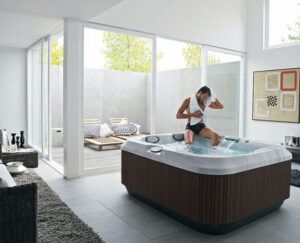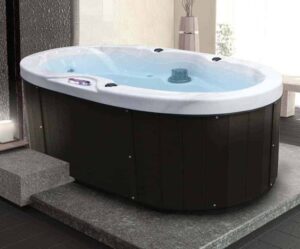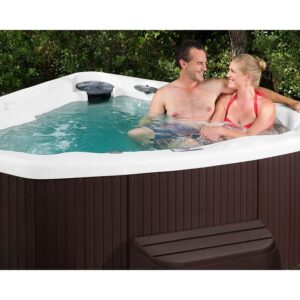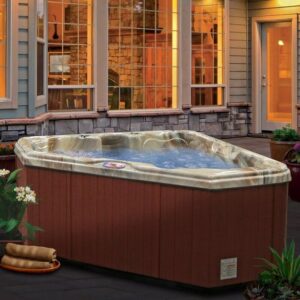Unveiling the Warmth: How Hot Are Hot Tubs?

Navigating the ideal hot tub temperature is essential for ensuring a safe and enjoyable experience in hot tubs. It is essential to have a balance between comfort and safety, with the hot tub water temperature typically maintained between 100°F and 102°F. This range is considered the ideal hot tub temperature for most adults, providing a soothing environment that promotes relaxation and muscle relief. However, adjustments are recommended for special conditions, such as safe hot tub temperatures for kids and pregnant women, to ensure the hot tub remains a haven for all users.
Seasonal variations and personal preferences play a significant role in determining the perfect hot tub temperature for each individual. Whether adjusting the hot tub temperatures to suit warmer climates or seeking a cooler soak during hot summer days, the flexibility in controlling the hot tub water temperature ensures hot tubs can provide year-round enjoyment.
It’s important to understand how hot tub temperatures affect the body and to adhere to recommended guidelines to prevent heat-related health risks, making every soak in hot tubs a perfectly balanced experience of warmth and wellness.
The Core of Warmth: Understanding Hot Tub Temperatures
Hot tubs offer a unique blend of relaxation and therapeutic benefits, much of which is attributed to the water temperature. The general range of temperatures for most hot tubs hovers between 100°F to 104°F, closely mirroring the body’s own average body temperature.
This specific setting is crucial, as the right hot tub temperature enhances the hot tub experience by promoting relaxation and aiding in muscle recovery. It’s the hot tub heater that allows for precise control over this aspect, making the significance of the temperature setting a key factor for hot tub owners to consider for an optimal soaking experience.
The Ideal Hot Tub Temperature for Relaxing

Finding the perfect hot tub temperature for relaxation is a personalized journey, as the universally accepted ideal spa temperature sits at about 102°F. This temperature is often preferred because it is comfortably above body temperature yet safe enough to prevent overheating during extended sessions using a hot tub.
Factors such as individual health conditions, personal comfort preferences, and even the outdoor climate can influence what constitutes the perfect temperature for someone. Ultimately, maintaining a safe hot tub temperature that closely aligns with the user’s perfect temperature ensures a relaxing and enjoyable hot tub experience for all.
Navigating Temperatures: Safety First
The best hot tub temperatures are those that allow users to relax in warm water without the danger of heat-related illnesses such as heat stroke. As a hot tub owner, it’s essential to familiarize yourself with these safety guidelines, which are designed to protect all users.
Safe Temperatures for Kids
For children, the recommended hot tub temperature should be slightly lower than that for adults to prevent overheating and the associated risks. Experts suggest that the temperature a hot tub should be for kids is no more than 95°F, coupled with strict supervision and limited time spent in the water. These precautions ensure that children can enjoy the benefits of warm water safely. As a hot tub owner, it’s your responsibility to ensure these guidelines are followed, promoting a safe environment for the youngest users.
Safe Temperatures While Pregnant
Pregnant women should also exercise caution when using hot tubs, adhering to a safe temperature range to avoid any potential harm to themselves or their unborn child. The recommended temperature for a hot tub for pregnant women should not exceed 100°F. This lower temperature limit helps minimize the risk of heat stroke and other heat-related complications, which can be more prevalent during pregnancy. Understanding and implementing these specific recommendations is vital for ensuring the safety and well-being of expectant mothers during their hot tub experience.
Natural Warmth: Hot Springs vs Backyard Spa

The allure of soaking in warm water transcends the confines of man-made structures, extending to the natural serenity of hot springs and the modern convenience of backyard spas.
Hot Springs
Hot springs, nature’s own hot tubs, offer varying water temperatures, often above the human body temperature, sometimes reaching upwards of 104°F. The earth’s core heats these natural pools, revered not only for their warmth but also for their mineral-rich waters with believed healing properties. The connection to nature and the unique composition of hot springs provide a distinct experience compared to manufactured spas.
Backyard Spa
Backyard spas, on the other hand, allow hot tub users to control water temperatures precisely, typically setting a maximum temperature of 104°F to minimize heat-related health risks. These manufactured hot tubs provide a consistent and convenient way to enjoy warm water, making it easy to maintain the ideal temperature for relaxation and health benefits. Especially for pregnant women, the ability to adjust the water temperature a few degrees below the maximum can ensure a safer soaking environment.
Factors that Affect Water Temperature in a Hot Tub
Several environmental and technical factors play a crucial role in determining the actual hot tub water temperature.
External Temperature: Cold air can significantly reduce hot tub water temperatures, necessitating more energy to maintain the ideal temperature.
Heating System Efficiency: The capability of the hot tub’s heater to quickly and efficiently raise human body temperature to the desired warmth without excessive energy use.
Usage Frequency: Frequent use can cause fluctuations in water temperatures as the hot tub works harder to return to the ideal temperature.
Hot Tub Cover Quality: A high-quality cover can mitigate the effects of cold air, helping to maintain consistent water temperatures by minimizing heat loss.
Sun Exposure: Direct sunlight can naturally increase hot tub water temperature by a few degrees, reducing the need for electrical heating.
Wind Exposure: Wind not only cools the water’s surface but can also make it challenging to maintain a stable temperature, especially in exposed areas.
Water Volume: Larger volumes of hot tub water require more time and energy to reach the ideal temperature, influencing the heating process.
The Health Aspect: What Are Heat-Related Health Risks?

Excessive heat exposure during hot tub use can lead to several health risks, including dehydration, heat exhaustion, and even heat stroke. These conditions arise when the body’s internal temperature is elevated beyond its normal range, disrupting the natural mechanisms for regulating heat.
To avoid such heat-related health issues, it’s crucial for spa owners to monitor the duration of their soak and ensure the spa water is at a proper temperature that doesn’t overly elevate the body’s internal temperature. Staying hydrated and limiting time spent in heated water can further mitigate these risks, ensuring a safe and enjoyable experience.
Crafting the Perfect Soak: Adjusting Your Hot Tub Temperature
Maintaining an ideal hot tub temperature is key to enjoying both comfort and health advantages. Personal preference and health needs play a significant role in determining the right temperature, aiming for a balance that ensures the water is consistently comfortable. Effective heat retention not only boosts energy efficiency but also keeps the spa water at a steady, enjoyable temperature. Tailoring the temperature to individual preferences allows spa owners to optimize their hot tub experience, ensuring it’s neither too hot nor too cold.
What Is the Perfect Water Temperature for My Hot Tub?
Determining the ideal temperature for your hot tub involves considering personal preference and the physical effects of heated water on the body. Most users find a temperature range between 100°F and 102°F to be a comfortable temperature that promotes relaxation and improves blood flow without overstressing the body. Adjusting the temperature to a slightly lower or higher setting based on individual comfort and underlying health conditions can help optimize the benefits of hot tub use. Keeping the water at a consistent temperature that suits personal preference ensures an enjoyable and therapeutic hot tub experience.
Is 90 Degrees Too Cold for a Hot Tub?
No, it’s not too cold for everyone. For those with specific health conditions or a preference for cooler water, 90 degrees Fahrenheit can offer a comfortable and therapeutic experience. This temperature can still promote relaxation and improve blood flow without the risks associated with higher temperatures, making it a more energy-efficient option as well. The suitability of 90 degrees depends on individual preferences and health considerations, highlighting the importance of personalizing your hot tub settings.
A Warmth for Every Season: Hot Tub Temperature During Different Seasons

Adjusting your hot tub’s temperature to suit the changing seasons can enhance your soaking experience, ensuring comfort year-round. Here’s a guide to the ideal hot tub temperatures for different seasons:
Spring: As the air begins to warm, setting your hot tub around 100 to 102 degrees Fahrenheit offers a comfortable transition from the cooler days.
Summer: Lower temperatures, such as 98 to 100 degrees Fahrenheit, provide a refreshing respite from the summer heat.
Fall: As the temperature cools, a setting of 102 to 104 degrees Fahrenheit can keep the chill at bay, making your hot tub a cozy autumn retreat.
Winter: In the coldest months, maintaining the water temperature at 104 degrees Fahrenheit ensures the hot tub remains a warm and inviting sanctuary against the freezing outside air.
These seasonal adjustments ensure that your hot tub remains a source of relaxation and comfort, regardless of the weather, while also helping to prevent overheating and minimize health issues associated with improper temperature settings.
Ideal Hot Tub Temperature According to Different Conditions, Gender, and Ages
Factors such as age, health conditions, and gender significantly influence the right temperature for hot tub use across different groups. For fully healthy adults, a temperature of around 102 degrees Fahrenheit is often ideal, offering a balance that maximizes health benefits without posing blood pressure problems or other health risks. However, for those with medical conditions, seeking advice from a medical professional is advisable to determine the safest set temperature.
Adjusting for low temperatures can accommodate the entire family, including those at increased risk or with specific health concerns, ensuring everyone can enjoy the hot tub’s warmth safely. By considering the body’s ability to regulate temperature and individual health backgrounds, spa owners can create an inclusive environment that caters to the diverse needs of friends and family.
The Technical Side: Maintaining Your Hot Tub’s Ideal Temperature

Efficient temperature management in your hot tub doesn’t have to be a constant task. Here are some concise tips for keeping your hot tub at the ideal temperature:
Use Quality Hot Tub Covers: A well-fitted cover prevents heat loss when the tub is not in use, maintaining the water’s warmth without additional heating.
Invest in Good Insulation: Proper insulation around the hot tub helps retain heat, reducing the need for the heating system to work overtime to keep the water at the desired temperature.
Adopt Energy-Efficient Heating Practices: Utilizing energy-efficient heaters or solar covers can maintain the ideal temperature more effectively, ensuring the water stays warm without excessive energy use.
In Summary
We’ve emphasized the critical aspects of managing the temperature of hot water in most hot tubs to ensure both safety and relaxation. The right spa temperature is essential not only to avoid health issues but also to maintain an optimal body temperature, enhancing the therapeutic benefits of using a hot tub. We encourage hot tub owners, especially those with modern hot tubs, to consider their personal needs and preferences alongside the recommended safe hot tub temperature guidelines to find the temperature that a hot tub should ideally have for them, ensuring a balance between comfort and health.
Discover how to tailor your hot tub experience for the ultimate comfort and safety by exploring more about your hot tub options. Contact us today!
